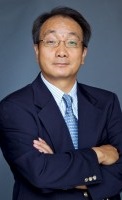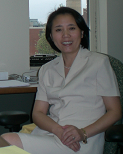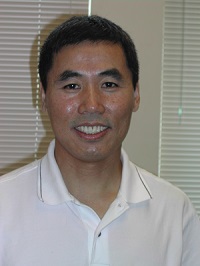Keynote Speakers

Prof. Zheng-Hong Lu
University of Toronto, Canada
(Fellow of CAE, FAAAS)
Dr. Zheng-Hong Lu is a full professor and a Tier I Canada Research Chair in Organic Optoelectronics at the University of Toronto. He received a PhD degree in engineering physics in 1990 from Ecole Polytechnique of the University of Montreal, Canada. Prior to his current appointment, he was employed by the National Research Council (NRC) as an assistant and then an associate research officer. While at NRC he developed a number of materials and processes for microelectronics and optoelectronics, in particular, light-emitting silicon superlattices, dielectrics for silicon transistors, and surface passivation for solid-state lasers. In 1998, he moved to the University of Toronto to create an Organic Optoelectronics Research Group. His group’s research includes OLED materials and device engineering for flat-panel display and solid-state lighting applications. Getting more here: http://mse.utoronto.ca/faculty-staff/professors/lu/

Prof. Hao Gong
National University of Singapore, Singapore
Dr. Hao GONG is a Full Professor of Materials Science and Engineering at
National University of Singapore. He is also the coordinator of the
transmission electron microscopy laboratory at Department of Materials
Science and Engineering. His research interests include transparent oxide
conductors and semiconductors (n-type and p-type), energy storage materials
and devices (mainly supercapacitors), energy harvest materials and devices
(mainly solar cells), gas sensors, functional thin film and nano-materials,
materials characterization (mainly on transmission electron microscopy and
electron diffraction).
Dr. Gong received his B.S. degree in Physics at Yunnan University in 1982.
He passed his M.S. courses in Yunnan University, carried out his M.S. thesis
research work at Glasgow University, UK, and received M.S. degree of
Electron and Ion Physics at Yunnan University in 1987. He then did his PhD
at Materials Laboratory at Delft University of Technology, the Netherlands,
and obtained PhD degree there in 1992. He joined National University of
Singapore in 1992, and is currently full professor at Department of
Materials Science and Engineering. He has published about 200 refereed
papers in major international journals and a few US patents. He has
delivered several invited talks at international conferences. He has been
chairman or committee member of several international conferences, and
editor of special issues of some journal.
Invite Speakers

Prof. Ju Chou
Florida Gulf Coast University, USA
Title: Visualizing uptake of gold nanoparticles in live breast cancer cells and Zebra Fish
Abstract: Gold nanoparticles possess distinctive physicochemical properties and can be used as unconventional therapeutic approaches for targeting of cancer cells. However, the mechanism of the interaction between gold nanoparticles and cancer cells is still not clear. The purpose of this study was to grow gold nanoparticles with controlable particle sizes and use them to study their transport and diffusion in live breast cancer cells MCF-7 and zebra fish. We treated MCF-7 with 8 nm gold nanoparticles for 72 hours and visualized gold nanoparticles in the live cancer cells for different transport times. A dark field optical microscope (DFOM) was used to examine their transport and accumulation in the cancer cells as shown in Figure 1. Two concentrations of gold nanoparticles were tested in MCF7 cancer cells to determine the transport rate of the gold nanoparticles in the cancer cells. The results show that gold nanoparticles were able to enter not only cell membranes, but also nucleus of cancer cells. The transport or accumulation rate of gold nanoparticles in cancer cells was dependent on the time and the concentration of gold nanoparticles.
Biodata: Dr. Ju Chou is currently an Associate Professor in the Department of Chemistry and Physics at Florida Gulf Coast University. Dr. Chou received her Ph.D. in chemistry from Chinese Academy of Science, Changchun, China in 1995. After that, Dr. Chou has worked as a postdoctoral fellow in RIKEN Research Institute in Japan for a year during 1996-1997. She came to the United States as a visiting research scholar working at University of California-Irvine and later at University of California-Santa Barbara, respectively. Dr. Chou’s research areas include bio-electrochemistry of proteins such as cytochrome c, myoglobin and hemoglobin, bioaccumulation of trace elements in tissues, synthesis and characterization of nanomaterials such as gold nanoparticles and their biomedical applications. Dr. Chou’s recent research interests also include green synthesis of gold nanoparticles and environmental analysis of toxic metals in water, soil and human hair. She has also been collaborating with biology professors on the application of gold nanoparticles in biological systems such as cancer cells and zebrafish embryos. This research focuses on the design of model nanoparticles for potential application in in vitro and in vivo assays of studying toxicity, biocompatibility and transport of gold nanoparticles.

Prof. Qingsong Yu
University of Missouri, USA
Dr. Qingsong Yu is a Full Professor in the Department of
Mechanical and Aerospace Engineering at University of Missouri in the United
States. Dr. Yu’s research has been focusing on non-thermal gas plasma
technology and its applications in materials processing, surface
modification, thin film deposition, and recently in plasma medicine and
plasma dentistry.
Dr. Yu received his B.S. in Chemical Engineering from Tianjin University of
China, and his M.S. and Ph.D. in Chemical Engineering from University of
Missouri (1995, 1998). Since then, Dr. Yu has worked in microelectronics
industry at Silicon Valley in California. In 2002, he joined the faculty in
the Department of Chemical Engineering at University of Missouri and now he
is a Professor in the Department of Mechanical and Aerospace Engineering at
University of Missouri. Dr. Yu has published over 100 refereed research
papers in major international journals and holds a few US patents.
